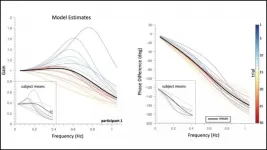(Press-News.org) A first-of-its-kind study led by The University of Texas at Austin has found that rock weathering and water storage appear to follow a similar pattern across undulating landscapes where hills rise and fall for miles.
The findings are important because they suggest that these patterns could improve predictions of wildfire and landslide risk and how droughts will affect the landscape, since weathering and water storage influence how water and nutrients flow throughout landscapes.
"There's a lot of momentum to do this work right now," said study co-author Daniella Rempe, an assistant professor at the UT Jackson School of Geosciences Department of Geological Sciences. "This kind of data, across large scales, is what is needed to inform next-generation models of land-surface processes."
The research was led by Michelle Pedrazas, who conducted the work while earning a master's degree at the Jackson School. It was published in the Journal of Geophysical Research: Earth Surface.
Despite the importance of what's happening inside hills, most computer models for simulating landscape behavior don't go deeper than the soil due to a lack of data that can scale to large areas, Rempe said.
This study helps fill that knowledge gap, being the first to methodically sample the interiors of a sequence of hill slopes. The research focused on investigating the "critical zone," the near surface layer that includes trees, soils, weathered rock and fractures.
"This study helps to unravel a mystery in the critical zone research community, the linkage between bedrock weathering, topography and storage of water in mountainous watersheds," said Eric Pierce, the director of the Environmental Sciences Division at Oak Ridge National Laboratory who was not involved with the study.
The research site is in Northern California and is part of a national network of Critical Zone Observatories. The scientists drilled 35 boreholes across a series of hill slopes and their valleys to collect subsurface samples and other data. They also collected a core sample at the peak of each hill slope that captured the entire height of the hill - a distance that varied from 34 to 57 feet (10.5 to 17.5 meters).
The samples revealed deeper weathering and fracturing in hilltops and thinner weathering in valleys, in addition to weathering that penetrates deeper into shorter hill slopes than taller ones.
This finding is important because it suggests that computer models could use this scaling trend to model the extent of weathering in similar undulating terrain.
Where water is stored in the weathered rocks of hill slopes is an important question, especially during the arid summers experienced in the field area. Research led by Rempe in 2018 revealed that trees tap into water stored as "rock moisture" in the fractures and pores of critical zone rocks during droughts.
This study also revealed rock moisture in the critical zone - but only within the first 20 feet of weathered rock.
Learning more about how hill slopes store their water can help researchers determine what areas are most at risk of becoming wildfire hazards. Pedrazas said that the wildfire connection was clear when they collected the field data in 2018. Wildfires blazing in other parts of California turned the sun red and filled the sky with smoke. The setting underscored the fact that knowing what's happening at the surface is closely connected to what's happening within the hills.
"We were really seeing the potential impact of our research, [the importance of] where is the water, and when are trees really going to dry up, and what risk that is for society," Pedrazas said.
INFORMATION:
Three other Jackson School scientists co-authored the study: then-postdoctoral researcher Jesse Hahm, doctoral student Mariel Nelson and then-undergraduate student Rachel Breunig. The study was also co-authored by researchers from Simon Fraser University, the University of Maryland, the United States Forest Service, Vanderbilt University and the University of California, Berkeley.
The U.S. Department of Energy, the National Science Foundation and support from affiliated universities funded the research.
The fact that the human body is made up of cells is a basic, well-understood concept. Yet amazingly, scientists are still trying to determine the various types of cells that make up our organs and contribute to our health.
A relatively recent technique called single-cell sequencing is enabling researchers to recognize and categorize cell types by characteristics such as which genes they express. But this type of research generates enormous amounts of data, with datasets of hundreds of thousands to millions of cells.
A new algorithm developed by Joshua Welch, Ph.D., of the Department of Computational Medicine and Bioinformatics, Ph.D. candidate Chao Gao and their team uses online learning, greatly speeding up this process and providing a way for researchers ...
A lot about the human brain and its intricacies continue to remain a mystery. With the advancement of neurobiology, the pathogenesis of several neurodegenerative diseases (ND) has been uncovered to a certain extent along with molecular targets around which current therapies revolve. However, while the current treatments offer temporary symptomatic relief and slow down the course of the disease, they do not completely cure the condition and are often accompanied by a myriad of side effects that can impair normal daily functions of the patient.
Light stimulation has been proposed as a promising therapeutic alternative for treating various ND like ...
The brain's auditory system tracks the speed and location of moving sounds in the same way the visual system tracks moving objects. The study recently published in eNeuro lays the groundwork for more detailed research on how humans hear in dynamic environments.
People who use hearing aids have trouble discriminating sounds in busy environments. Understanding if and how the auditory system tracks moving sounds is vital to improving hearing aid technology. Prior research utilizing eye movements to gauge whether the brain is following the trajectory of a moving sound indicates it cannot. A new study from García-Uceda Calvo et al. instead used head movements, a more accurate measure of sound tracking.
The team analyzed head movements of hearing ...
April 19, 2021--(BRONX, NY)--Researchers at Albert Einstein College of Medicine have developed a topical drug that regenerates and restores the function of erectile nerves damaged by radical prostatectomy, the most common treatment for localized prostate cancer. The drug was tested in rats, and the findings were published online today in JCI Insight.
"Erectile dysfunction (ED) after radical prostatectomy has a major impact on the lives of many patients and their partners," said study co-leader David J. Sharp, Ph.D., professor of physiology & biophysics and of ophthalmology and visual sciences and professor in the Dominick P. Purpura Department of Neuroscience at Einstein. "Since rats are reliable animal models in urologic research, our drug offers real hope of normal sexual ...
DALLAS - April 19, 2021 - Treating people with Type 2 diabetes with a new once-a-week injectable insulin therapy proved to be safe and as effective as daily insulin injections, according to the results of two international clinical trials published online today in Diabetes Care. The studies suggest that the once-weekly treatment could provide a convenient alternative to the burden of daily insulin shots for diabetes patients.
Starting and maintaining insulin treatment remain a challenge for millions of patients worldwide with Type 2 diabetes. Fear of injections and the inconvenience and burden of injectable therapy contribute to the barriers against insulin therapy initiation and adherence. The effectiveness and safety of ongoing insulin treatment are also highly dependent ...
Data from a GPS network in Colombia have revealed a shallow and fully locked part on the Caribbean subduction zone in the country that suggests a possible large earthquake and tsunami risk for the northwest region.
The locked patch south of Cartagena city is capable of generating a magnitude 8.0 earthquake every 600 years, said Sindy Lizarazo of Nagoya University in Japan, who presented the study at the Seismological Society of America (SSA)'s 2021 Annual Meeting.
Colombia lies in the middle of a complex tectonic zone, where the Caribbean, Nazca and South American tectonic plates and other smaller tectonic blocks converge. The Caribbean plate ...
Boston College seismologist John Ebel and his colleagues have noted a pattern for some large California earthquakes: magnitude 4 or larger earthquakes occur at a higher rate along a fault in the two decades or more prior to a magnitude 6.7 or larger earthquake on the fault.
The findings prompted Ebel in 2017 to suggest a prospective test. He looked for the California faults that had magnitude 4 or larger earthquakes occurring at a rate higher than 0.5 earthquakes per year from 1997 to 2016. If the pattern holds, the next magnitude 6.7 earthquakes in California are most likely to ...
Eighteen minutes might be all it takes to ensure a full recovery for stroke patients in rural South Carolina.
By changing EMS workflows and incorporating telemedicine techniques, physicians at MUSC Health have partnered with Georgetown Memorial Hospital and Hampton Regional Medical Center to significantly shorten the time between a patient's stroke symptom onset and their treatment, as recently reported in the Journal of Stroke and Cerebrovascular Diseases.
Through MUSC Health's Telestroke Network, emergency medical technicians (EMTs) can video chat with stroke specialists to begin a patient's consult before they even arrive at the hospital. ...
A new study finds a naturally occurring "earthquake gate" that decides which earthquakes are allowed to grow into magnitude 8 or greater.
Sometimes, the "gate" stops earthquakes in the magnitude 7 range, while ones that pass through the gate grow to magnitude 8 or greater, releasing over 32 times as much energy as a magnitude 7.
"An earthquake gate is like someone directing traffic at a one-lane construction zone. Sometimes you pull up and get a green 'go' sign, other times you have a red 'stop' sign until conditions change," said UC Riverside geologist Nicolas Barth.
Researchers learned about this gate while studying New Zealand's Alpine ...
April 19, 2021 - At the current rate of change, it will take more than 200 years for the proportion of women in orthopaedic surgery to reach parity with the overall medical profession, according to a study in Clinical Orthopaedics and Related Research® (CORR®), a publication of The Association of Bone and Joint Surgeons®. The journal is published in the Lippincott portfolio by Wolters Kluwer.
"Substantive changes must be made across all levels of orthopaedic education and leadership to steepen the current curve," concludes the report by Atul F. Kamath, MD, of the Cleveland Clinic Foundation and colleagues. "Our findings support the need for changes in medical schools, orthopaedic residency ...




